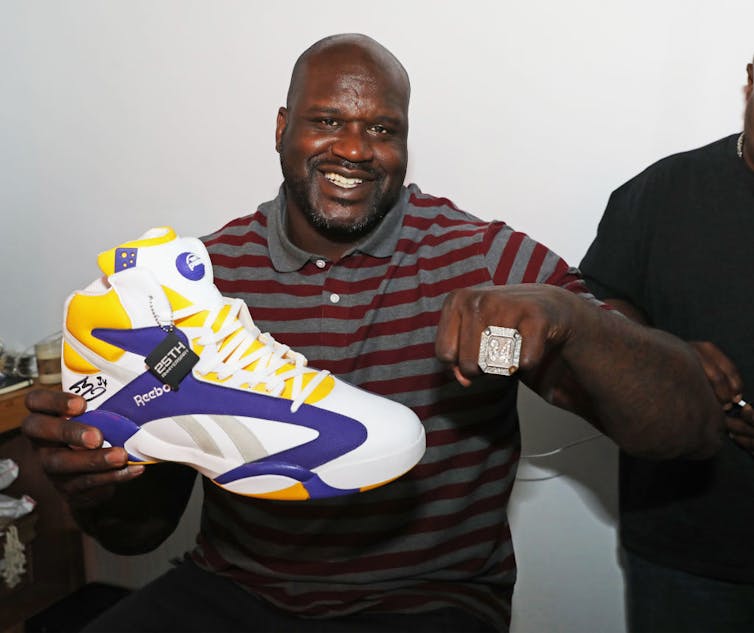Keeping NBA players on the court is no small 'feet'
The gargantuan feet of NBA players are the stuff of legend. But nearly two-thirds of their injuries occur below the waist, and they have a 25.8% chance of incurring an ankle injury every season.

The NBA playoffs provide a stage for some of the biggest and tallest athletes in the world. With an average height of 6 feet, 7 inches and an average weight of 225 pounds, players have a lot of skin, bone and muscle to support.
That’s why their feet play such an outsize role – literally and figuratively.
As a physical therapist and researcher who works closely with NBA athletes, I know just how difficult it is to maintain the health of players who are on the higher end of the foot-size spectrum.
And so while fans eagerly anticipate eye-popping dunks and crafty assists, I’ll be keeping an eye on the footwork of players like Kevin Durant, Joel Embiid and Lebron James, each of whom has had challenges keeping their feet healthy.
The importance of a strong foundation
NBA players’ bodies take a beating.
They jump and come crashing down to the court up to 70 times per game, with centers – typically the tallest players on the court – usually jumping the most.
When players land, the impact on the ground can be as high as four to six times their body weight. The average player also changes direction every two to three seconds, requiring stopping, turning and accelerating. Together, the jumps, twists, dekes and sprints put immense pressure on players’ foot, ankle and knee joints.
Like a tall building, basketball players need a solid foundation to support their massive bodies and withstand the power that is generated by all of this movement.
This is where the feet come in. The average shoe size of NBA players is close to a U.S. size 15. NBA Hall-of-Famers Shaquille O'Neal and Bob Lanier famously wore size 22 shoes. Among current players, Kevin Durant (18), Andre Drummond (19), Brook and Robin Lopez (20), Karl Anthony Towns (20) and Tacko Fall (22) lead the pack. The typical shoe size for an American adult male is 10.5.

Having big feet means having big bones that act as levers to create forces needed for athletic maneuvers. The foot’s 26 bones are intricately linked together with a series of 33 joints and bound together by soft tissues like muscles, tendons and ligaments. The big toe, the arch of the midfoot and the ankle are the gears that facilitate motion.
The soft tissue that connects these joints acts like a spring. Energy must be transferred from one joint to the other in a leverlike system that allows athletes to propel themselves forward when running and jumping. Likewise, these joints need to work together to absorb the shock of landing, slowing down or changing directions.
If this structure is not sound, the entire process can break down.
What goes up must come down
According to sports medicine specialist Mark C. Drakos, 62% of injuries in the NBA occur below the waist, with foot and ankle injuries accounting for over 22% of them. Ankle injuries are the most common: A player has a 25.8% chance of incurring one over the course of a season.
Stress fractures, while less common, can be particularly debilitating, lingering for weeks or months. The most common bones in the feet and lower leg to experience stress fractures are the navicular, talus, tibia and fibula.
Orthopedic surgeon Moin Kahn conducted a case study and found that only 30% of the athletes who incurred a stress fracture from 2005 to 2015 were able to return to their previous level of play a year after their injury.
Having big feet doesn’t mean that an NBA athlete is destined to have an injury. But many big men have had their struggles. This list includes former players Bill Walton, Arvydas Sabonis, Yao Ming and Greg Oden, all of whom wore size 19 shoes.
Standing at 7 feet, 3 inches, NBA prospect Victor Wembanyama has already had his fair share of health issues, including a fibular stress fracture. He wears a size 20.5 shoe.
Getting off on the right foot
Our research team has been studying joint range of motion, arch mobility, and foot and ankle mechanics in NBA players to help athletes mitigate these injury risks.
Part of that work involves building a database that includes the normal clinical measurements for elite basketball players – big toe extension, arch mobility, ankle flexion, hamstring flexibility and hip range of motion.
Understanding normal physical dimensions helps physical therapists and trainers to understand the risk of injury based on vulnerabilities in a player’s physical makeup.
For example, the average range of the big toe’s extension for the general population is 60 degrees. However, our research shows that the average NBA front court player has motion that is about 40 degrees. This means that the typical NBA player has feet and ankles that are stiffer than the average person’s.
While this stiffness can be advantageous and work like a coiled spring that helps a basketball player run and jump, physical therapists must constantly work on these muscles to loosen them up. That’s because too much stiffness can cause bone injuries.
Understanding what is happening during the heat of the action is also important.
We found that Achilles tendon tears tend to occur when the ankle bends more than 48 degrees. We suspect that this can happen when players’ ankles aren’t stiff enough: The tendon can’t adequately withstand the forces it encounters during game play.
The foot – a complex network of bones, joints and tissue – is ultimately only as strong as its weakest link. And the health of a team’s feet can end up being the one thing standing between them and a championship.
Philip Anloague does not work for, consult, own shares in or receive funding from any company or organization that would benefit from this article, and has disclosed no relevant affiliations beyond their academic appointment.
Read These Next
What’s at stake in Trump’s executive order aiming to curb state-level AI regulation
In the absence of comprehensive federal AI regulation, states have stepped in. The Trump administration,…
The Bible says little about Jesus’ childhood – but that didn’t stop medieval Christians from enjoyin
Legends about Jesus’ early years that circulated in medieval Europe often drew on apocryphal texts.
Data centers need electricity fast, but utilities need years to build power plants – who should pay?
How many data centers will be built – and how much electricity they’ll need – is uncertain. Being…





